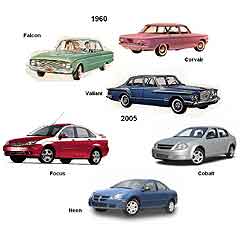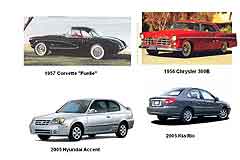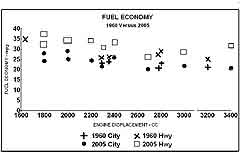
Back in the 1957, Chevrolet made headline news when the fuel-injected, 283 cid V8 used in the Corvette, and available in other Chevrolets, produced 283-horsepower - the then magic one-horsepower-per-cubic-inch-of-displacement (cid) benchmark. Today, even the four-cylinder, 1.6-liter (97 cid) engines in economy cars like the current Hyundai Accent and Kia Rio produce over 100-horsepower. While today’s vehicles are rated at higher rpm, (revolutions per minute - is horsepower is directly related to engine speed), the ratings are the more conservative net horsepower figures rather than the more optimistic gross horsepower ratings used before the early 1970s by American carmakers.
Today’s Corvette’s Z06 V8 produces 505-horsepower from 425 cid (7-liters) and the HEMI V8 in Chrysler’s new 300 SRT8 gets 425-horsepower from 370 cid (6.1-liter). Likewise, another indicator of performance, 0-to-60 mph times have gone down significantly. A 2005 Honda Accord could keep up with a 1958 Corvette “Fuelie” and a 2005 Camry could blow the doors off a basic 1958 Corvette. Finally, all you have to do is drive a car from the ‘60s, ’70s, or even the early ’80s to see how handling and braking has improved.

Unfortunately, similar improvements have not occurred in the fuel economy department as seen on the accompanying chart. Shown here are EPA city and highway mpg (miles per gallon) for comparable 1960 and 2005 model cars. The 1960 economy cars include the Ford Falcon, Chevrolet Corvair, Plymouth Valiant, Studebaker Lark, Rambler American and Volkswagen Beetle. These were compared against today’s Ford Focus, Dodge Neon, Chevrolet Cobalt, Nissan Sentra and Toyota Corolla.
Could it be that automaker’s are in cahoots with the oil companies to sell more gasoline, as well as local, state and federal governments to collect more fuel taxes? More likely, it is because performance still sells better than fuel economy in the consumer-driven automobile market.

Incidentally, on a trip to Europe I saw people filling up BMW 750’s and S-Class Mercedes with the equivalent of 25 gallons of gasoline, at $5.50 per-gallon. If this is any indication of the American motorist mindset, it could be a long time before American automakers produce truly fuel-efficient vehicles, and more importantly, we buy them in mass quantities.




